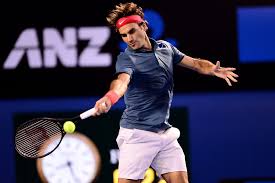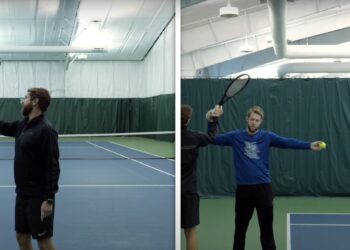There are a million options. They all look slick.
They’re loaded with buzzwords like “aerodynamic beam” and “pro tour stiffness.”
But what really matters is what the racquet can do for you. The racquet you swing with has a massive impact on how you play.
The right one can unlock control, confidence, and effortless power.
The wrong one?
It can quietly sabotage your timing, reinforce bad habits, and make you feel stuck.
This guide is built to answer one very real, very useful question: “What tennis racquet do I need?”
We’ll break down all the specs – weight, head size, length, string pattern, grip size, and explain how each spec ties into your actual game style, skill level, and swing mechanics.
By the time you’re done reading, you’ll not only know exactly what racquet specs to look for, you’ll learn why they matter, and how to pick a racquet that levels up your game, not just your gear bag.
If you’re a beginner, you’ll get a lot of value from this video that shows you every part of the racquet and shares the three best racquets for beginners
Racquet Anatomy: The Specs That Matter
If you’ve ever stared at a racquet chart and felt like you needed an engineering degree to decode it, don’t worry, you’re not alone.
But understanding a few key specs can completely change how confident you feel on court.
These aren’t just numbers; they’re the blueprint for how your racquet behaves when the ball is flying at you.
Let’s break it down.
Racquet Weight
Lightweight (<10 oz)
These racquets are easier to swing and great for beginners or players with shorter strokes.
But heads up – light doesn’t mean better.
You might lose some stability on off-center hits and give up control when things get fast.
Medium (10–11.5 oz)
This is the sweet spot for most intermediate players.
It gives you a balance of maneuverability and enough heft to stay solid through contact.
If you’re hovering around the 3.0–4.0 range, this is usually your safest bet.
Heavy (11.5+ oz)
These are built for advanced players who generate their own power.
If you’ve got long strokes and fast swing speed, a heavier racquet gives you the control to paint lines all day, but it’s unforgiving if your mechanics are off or you’re late to contact.
Pro tip: Players often overestimate their strength and grab a heavy racquet, only to end up with sore wrists and poor timing.
Lighter might feel less powerful, but it could actually help your game stay on schedule.
Racquet Balance
Head-Heavy: These racquets pack more mass in the head.
That means when you swing, the momentum carries through and adds free power. Ideal if you’ve got a compact stroke or you’re not generating pace on your own.
I recommend this setup for older players or doubles lovers who want easy depth on volleys and serves.
Head-Light: More of the weight is in the handle, making the racquet easier to maneuver and control.
If you’re a baseliner with big, loopy strokes (think Nadal), this lets you whip through the ball without spraying it.
Here’s the thing: balance matters as much as weight.
Two racquets can weigh the same but feel completely different depending on where that weight is placed.
Head Size
- Oversized (105–115 sq in): A bigger head = bigger sweet spot = more forgiveness. If you’re new to the game or you’re working on making clean contact, this is your racquet’s safety net.
- Midplus (98–104 sq in): The goldilocks of head sizes. Enough forgiveness for intermediates, enough precision for rising players. It’s the most popular range for a reason.
- Midsize (<98 sq in): These racquets are all about control. You’ll need excellent timing and mechanics, but the precision is unmatched.
Heads-up: Choosing too small a head before you’re ready is a recipe for frustration.
You don’t earn style points for struggling with a racquet that’s built for pros.
Grip Size
This one gets overlooked, and that’s a big mistake.
Too small? You’ll overgrip and strain your wrist.
Too big? You’ll lose maneuverability and feel clunky at the net.
Here’s the test: Grab a ruler.
Measure from the middle crease of your palm to the tip of your ring finger.
That number in inches is your grip size. If you’re in between, go smaller and use overgrips to build it up.
Remember: comfort is king. A proper grip size gives you better control, prevents injury, and helps your strokes stay smooth under pressure.
String Pattern & Tension
- Open Pattern (16×18): More space between strings means more spin and more pop. Perfect for players who want to dip balls into the court or add shape to their shots.
- Dense Pattern (18×20): Tighter strings equal more control and a flatter ball trajectory. This setup is built for precision and consistency.
Tension Tips:
- Lower tension = more power (but less control).
- Higher tension = more control (but less trampoline effect).
Don’t overthink it. Mid-range tension is a solid default for most players. Once you’re more advanced, you can experiment to match your feel.
Source -> https://theracketsports.com/parts-of-a-tennis-racket/
Choosing the Right Racquet for How You Play
There’s no “one racquet fits all” solution, because no two players swing the same way.
Your racquet should be a natural extension of how you play: your swing path, your strengths, your preferences.
Let’s look at these four main styles and the racquet builds that bring out the best in each.
If You Hit With Heavy Topspin
You live at the baseline.
You hit with a big, loopy backswing and whip through the ball with topspin so strong it kicks up like a mule on your opponent.
If that’s you, you want a racquet that enhances that spin, not one that flattens it out.
Look for:
- An open string pattern (16×18 or 16×19): This allows the strings to bite the ball and launch it with extra spin.
- A midplus head (100–104 sq in): Gives you margin for error without sacrificing control.
- A lighter racquet with a head-light balance: Lets you accelerate through the ball to generate spin and racket head speed.
Think Nadal. His strokes explode off the bounce. His racquet is built to help, not hinder, that motion.
If You Rely on Flat, Driving Shots
Your forehands are more like lasers than topspin lobs. You aim to hit through the court, not arc over it.
Precision is your game, and you want the racquet to feel like an extension of your arm.
You’ll want:
- A denser string pattern (18×20): Gives you that surgical, predictable ball flight.
- A smaller head (98 sq in or less): Enhances accuracy and minimizes string movement.
- A heavier frame: Stabilizes your stroke and absorbs the ball’s impact for better control.
Think Djokovic. He’s a master of clean, efficient power and directional control. His racquet setup is engineered for flat, fast, no-fluff tennis.
If You’re a Serve-and-Volley Player
You’re quick, aggressive, and spend more time at the net than most.
You rely on sharp angles, crisp volleys, and a serve that sets up easy put-aways.
You don’t need spin or brute force, you need maneuverability and feel.
Go for:
- A head-light racquet: Keeps your reactions fast at the net and helps you get into position.
- A smaller to midplus head size (95–100 sq in): Prioritizes control and accuracy.
- A slightly shorter racquet (27″ or under): Gives you quicker handling on volleys.
Think Federer. He danced around the net like a fencer, not a brute. His racquet gave him just the right mix of control and finesse to keep his hands smooth under pressure.
If You’re Just Starting Out
You’re still figuring out what your game is and that’s totally fine. At this stage, you want gear that helps you build confidence, not punish you for imperfect technique.
Start with:
- An oversized head (105–115 sq in): Gives you a larger sweet spot and forgiveness on off-center hits.
- A head-heavy frame: Helps add power when your strokes aren’t yet fully developed.
- A lightweight build (<10 oz): Makes it easier to swing and maneuver as you develop timing and coordination.
Biggest mistake I see? New players buying “what the pros use.”
Don’t do that.
Pros use advanced racquets built for control, not for learning. Start with tools that help you improve, then evolve as your game grows.
Junior & Youth Players: Size Guide
If you’ve got a young player at home or you’re shopping for your kid’s first racquet, this section is for you. And let me tell you, this is where a lot of parents go wrong.
They grab a racquet that’s “close enough,” thinking the kid will grow into it. But in tennis, close enough doesn’t cut it.
The wrong racquet size can make tennis frustrating instead of fun. And if it’s too heavy or too long? It can actually slow down progress and increase the risk of injury.
Kids need racquets that fit their height, hand size, and swing speed, not just their age. But as a general guide, here’s where to start:
- Ages 4–5: 19″ racquet
- Ages 6–8: 21–23″ racquet
- Ages 9–10: 23–25″ racquet
- Ages 11–12: 25–26″ racquet
- Age 13+ (or taller/pre-teen athletes): Move to a full-size adult racquet (27″)
Pro tip: If your child holds the racquet by their side and the tip drags on the ground, or the grip is thicker than a baseball bat, it’s too big. Go smaller.
You can always upgrade as they grow, but starting too big can build bad habits fast.
Don’t Make These Mistakes When Buying a Racquet
Choosing Based on Color or Brand Endorsement
We get it. A matte-black Babolat with gold lettering looks fast. And yes, Serena plays with Wilson. But brands and paint jobs don’t win matches – fit does.
Marketing is meant to sell racquets, not match them to your swing.
We’ve seen players light it up with lesser-known brands because the specs were perfect for their game.
Skipping Grip Size Measurements
This one’s big, and it’s almost always overlooked.
Players pick a grip by feel in the store or grab “whatever’s in stock.”
But if the grip is too small, you’ll over-grip and risk wrist injuries.
If it’s too big, you’ll lose feel, especially at the net.
Fix: Use the ruler test. Measure from the middle of your palm to the tip of your ring finger. That’s your grip size in inches. Round down if you’re between sizes and build it up with overgrips if needed.
Copying Your Favorite Pro Without Considering Your Game
Look, I love Federer’s racquet. But unless your technique is buttery smooth and your timing is elite, that frame will probably make you feel like a beginner again.
Pro racquets are designed for precision, not forgiveness.
If you’re not hitting the sweet spot every time, you’ll struggle with consistency and confidence. Instead, pick a racquet that elevates your strengths and gives you margin for error.
Think of your racquet as a teammate, not a trophy. It should support your game, not punish your mistakes.
Ignoring Balance and Swing Weight
Two racquets can weigh the exact same on a scale, but feel completely different when you swing them.
That’s because balance and swing weight determine how a racquet moves through the air.
If the racquet feels too sluggish, you’ll be late. If it’s too whippy, you’ll overhit. Get this wrong, and you’ll start missing shots you usually make and not know why.
Solution? Demo. Always demo.
Racquets Don’t Make Champions, But the Wrong One Will Hold You Back
You don’t need the most expensive racquet. You need the right racquet for you.
But a racquet alone isn’t enough. If you’re serious about improving, you need more than just the right gear. You need a system.
PlayYourCourt is no longer just a place to find a practice partner, we’re your all-in-one game improvement platform.
From custom racquet guidance to exclusive coaching videos, technique challenges, in-person workshops, and member-only competitions, we’re here to help you break through whatever’s holding you back.
So if you’re ready to level up your racquet and your game, explore our membership and get everything you need to play better tennis, faster.
Because improvement doesn’t happen by accident.
It happens by design. Let’s build it together. 🎾



